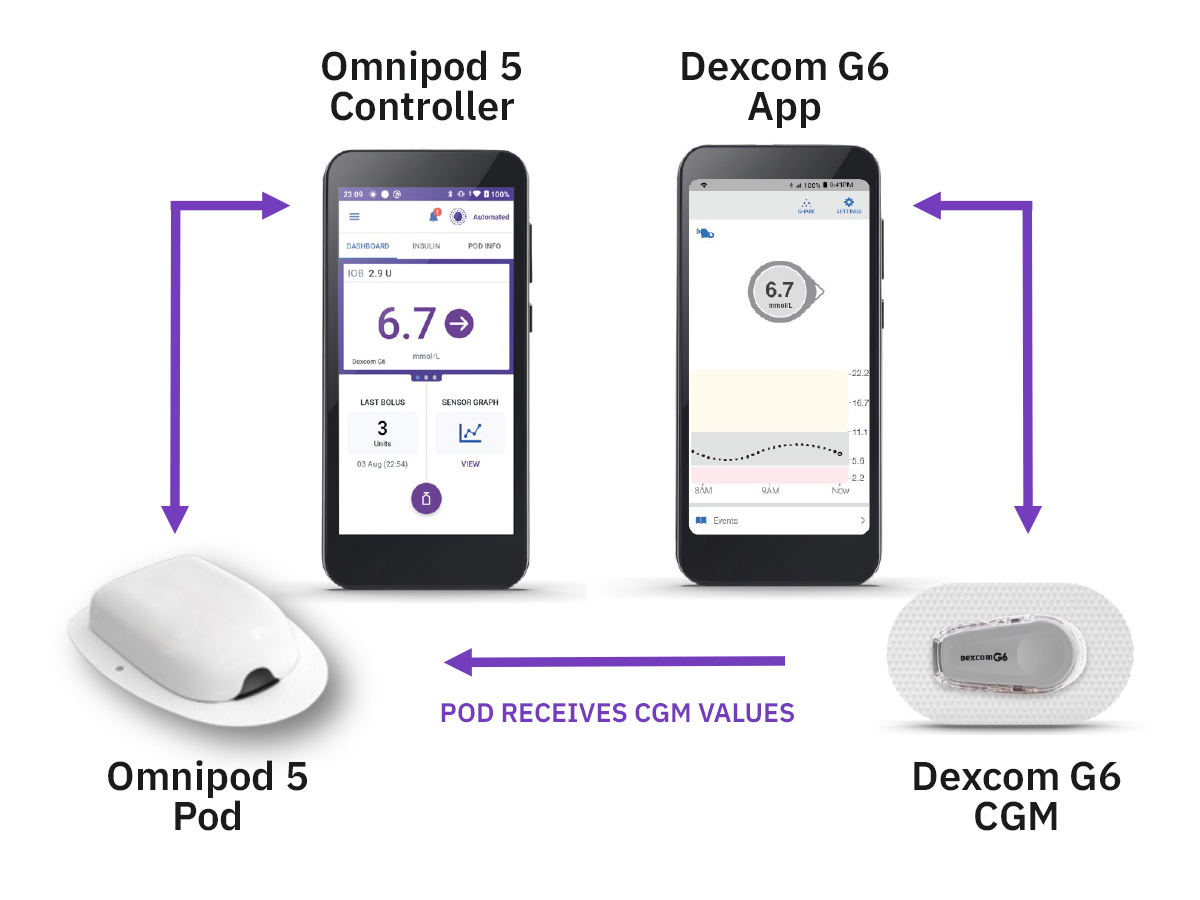Automated Insulin Delivery, explained.


What is Automated Insulin Delivery?
Automated insulin delivery (AID) systems, also known as Hybrid Closed-Loop (HCL) systems, combine an insulin pump and a continuous glucose monitor (CGM) to automatically deliver insulin based on real-time glucose readings.
AID uses an algorithm to frequently adjust insulin doses in small amounts, continuously adapting as the user’s blood sugar levels fluctuate.
With this precise and personalised dosing, automated insulin delivery can improve glucose control in addition to reducing some of the burden of diabetes management.
How does Automated Insulin Delivery work?
An AID system is made up of three main parts - an insulin pump, a CGM and a control algorithm.
Click on the modules below to learn about insulin pumps and CGMs in more detail or read on to learn how they work together with the algorithm to create some AID magic!
AID allows for a complete circle of communication between the insulin Pump or Pod, the CGM and a control algorithm. In simple terms, the CGM talks to the Pump or Pod where the algorithm then responds by automatically increasing, decreasing or pausing insulin delivery depending on whether glucose levels are rising or falling.
The systems adapt to your body’s unique needs and behaviours, taking into account things like food intake, exercise, and stress. You still need to bolus insulin for food and correction doses.
So, how does it work?
Generally, every 5 to 10 minutes:
- The CGM reports your glucose levels to the algorithm
- The algorithm calculates whether insulin delivery needs to be increased, decreased, remain the same or stopped completely
- The algorithm sends the command to the Pump or Pod
- The Pump or Pod actions the command
- The CGM picks up on any changes to your glucose level and reports that to the algorithm… and the circle continues. Hence the term ‘loop’.
How does this help people with type 1 diabetes?
AID systems are an exciting development in diabetes technology because the automated adjustments to insulin delivery can help to control blood glucose levels, reduce hypoglycaemia (low blood sugars) and increase time in range.
An AID system can help lessen the burden of managing your diabetes, as well as helping to reduce highs and lows throughout the day and night.
Additional features can also support people with diabetes during times of increased hypoglycaemia risk, like when exercising.
https://www.diabetes.org.uk/guide-to-diabetes/diabetes-technology/closed-loop-systems
https://jdrf.org.uk/information-support/treatments-technologies/continuous-glucose-monitors/hybrid-closed-loop-technology/
https://abcd.care/dtn/educational-resources-people-living-diabetes
There are several Hybrid Closed Loop systems now available in the UK, so speak to your diabetes team about the possible options. Below, you can learn more about Insulet’s AID System: The Omnipod® 5 Automated Insulin Delivery System.
Say hello to tubeless automated insulin delivery with Omnipod® 5
Omnipod 5 is the first tubeless AID system to integrate with the Dexcom G6 continuous glucose monitor*, offering automated insulin delivery with freedom from injections, tubes AND finger pricks**.
Omnipod 5 is approved for people living with type 1 diabetes aged 2 and older.
Automated Insulin Delivery, Simplified.


Dexcom G6 shown without necessary adhesive.
You choose your target glucose setting. There are 5 options between 6.1mmol/L and 8.3mmol/L.
Using our SmartAdjust™ algorithm, Omnipod 5 adjusts your basal insulin every 5 minutes by responding to the Dexcom G6 CGM data and trends.
Each wearable, waterproof‡ Pod continuously delivers insulin for up to three days (72 hours).
Bolus doses are given by you using the Omnipod 5 Controller.
The result? Less time low, more time in range and lower A1c.2
Additional Features of the Omnipod 5 AID System
SmartBolus Calculator.
You still deliver your bolus doses for food and manually dose insulin corrections for higher blood sugars, but the SmartBolus Calculator will suggest bolus amounts based on individual settings, entered values, and CGM trends if glucose levels are static, rising or falling.
Activity feature.
For times when your blood glucose typically goes low, like during exercise, enabling the Omnipod 5 activity feature will automatically increase the glucose target and reduce insulin delivery.
Is the Omnipod 5 right for me?
Frequently Asked Questions about Automated Insulin Delivery System
What is the Omnipod 5 Automated Insulin Delivery System?
Is an AID system the same as a Hybrid Closed-Loop system?
When will Omnipod 5 be available in the UK?
What do I need to know to be prepared for Omnipod 5?
References and Disclaimers:
2 Brown S. et al. Diabetes Care. 2021;44:1630-1640. Prospective pivotal trial in 235 participants with T1D aged 6 - 70 yrs. Study included a 14-day standard therapy (ST) phase followed by a 3-month Omnipod 5 hybrid closed-loop (HCL) phase. Mean time in range (70-180mg/dL or 3.9 – 10mmol/L) in adults/adolescents and children as measured by CGM: ST = 64.7%, 3-mo Omnipod 5 = 73.9%, P<0.0001; ST = 52.5%, 3-mo Omnipod 5 = 68.0%, P<0.0001, respectively. Mean time > 180 mg/dL (12AM-6AM) as in adults/adolescents and children, ST vs. 3-mo Omnipod 5: 32.1% vs. 20.7%; 42.2% vs. 20.7%, P<0.0001, respectively. Mean time >180 mg/dL (6AM -12AM) in adults/adolescents and children, ST vs. 3-mo Omnipod 5: 32.6% vs. 26.1%; 46.4% vs. 33.4%, P<0.0001, respectively. Median time in <70 mg/dL (12AM-6AM) in adults/adolescents and children, ST vs. 3-mo Omnipod 5: 2.07% vs. 0.82%,P<0.0001; 0.78% vs. 0.78%, P=0.0456, respectively. Median time <70 mg/dL (6AM-12AM) in adults/adolescents and children, ST vs. 3-mo Omnipod 5: 1.91% vs. 1.08%, P<0.0001; 1.17% vs. 1.62%, P=0.2545, respectively. Results measured by CGM.